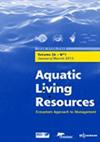Marine ornamental trade in Indonesia
IF 1.5
4区 农林科学
Q3 FISHERIES
引用次数: 13
Abstract
Trade with marine species as ornamentals is an important sector of the international pet trade. The vast majority of these species are collected from the wild and one of the top supplying countries is Indonesia. Detailed evidence on trade with marine resources in Indonesia is lacking or it is hardly accessible. Moreover, the exploitation of ornamental species seems to be mostly uncontrolled. This study presents detailed characteristics of such trade for Indonesia, including the offered species, their sizes, prices, and conservation status, based on data and information obtained from wholesalers in 2018. The main provinces of marine wildlife collecting are also identified. In total, 777 marine vertebrate and invertebrate species were traded, belonging to 174 families including two species classified as endangered: Banggai cardinal fish (Pterapogon kauderni) and zebra shark (Stegostoma fasciatum). Commonly traded was red lionfish (Pterois volitans), known to be a successful invader. The volume of ornamental marine fish exported from Indonesia in period 2015–2019 was 3 353 983 kgs sold for 33 123 218 USD. The province of Bali was identified as the main exporter of ornamental marine fish within Indonesia. These findings should help to establish sustainable exploitation of marine resources in relation to conservation and wildlife management.印度尼西亚的海洋装饰贸易
作为观赏动物的海洋物种贸易是国际宠物贸易的重要组成部分。这些物种中的绝大多数是从野外采集的,印度尼西亚是最大的供应国之一。关于印度尼西亚海洋资源贸易的详细证据缺乏,或者很难获得。此外,观赏物种的开发似乎大多不受控制。本研究基于2018年从批发商处获得的数据和信息,详细介绍了印度尼西亚此类贸易的特征,包括提供的物种、大小、价格和保护状况。并确定了海洋野生动物的主要采集省份。交易的海洋脊椎和无脊椎动物共777种,分属174科,其中Banggai cardinal fish (Pterapogon kauderni)和zebra shark (Stegostoma fasciatum) 2种被列为濒危物种。通常交易的是红狮鱼(Pterois volitans),众所周知,它是一种成功的入侵者。2015-2019年期间,印度尼西亚出口观赏鱼的数量为3 353 983公斤,售价为33 123 218美元。巴厘岛省被确定为印度尼西亚观赏海鱼的主要出口地。这些调查结果应有助于确定与养护和野生动物管理有关的海洋资源的可持续开发。
本文章由计算机程序翻译,如有差异,请以英文原文为准。
求助全文
约1分钟内获得全文
求助全文
来源期刊

Aquatic Living Resources
农林科学-海洋与淡水生物学
CiteScore
2.30
自引率
0.00%
发文量
10
审稿时长
>24 weeks
期刊介绍:
Aquatic Living Resources publishes original research papers, review articles and propective notes dealing with all exploited (i.e. fished or farmed) living resources in marine, brackish and freshwater environments.
Priority is given to ecosystem-based approaches to the study of fishery and aquaculture social-ecological systems, including biological, ecological, economic and social dimensions.
Research on the development of interdisciplinary methods and tools which can usefully support the design, implementation and evaluation of alternative management strategies for fisheries and/or aquaculture systems at different scales is particularly welcome by the journal. This includes the exploration of scenarios and strategies for the conservation of aquatic biodiversity and research relating to the development of integrated assessment approaches aimed at ensuring sustainable and high quality uses of aquatic living resources.
 求助内容:
求助内容: 应助结果提醒方式:
应助结果提醒方式:


